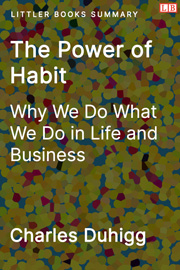Book Description
An exploration of how habits shape us and how we can change them to improve our lives, organizations, and communities.
If You Just Remember One Thing
Habits are powerful, automatic behaviors that are mad... More
Bullet Point Summary and Quotes
- A study involving mice finding chocolate in a maze showed that the mice's brain activity decreased as they repeated the task. This is evidence that the more we do something the easier it becomes. Forming automatic routines, or habits, is an energy-saving method of chunking tasks to make them easier to do.
- A 2006 research found that habits account for 40% of our daily actions.
- Habits are made up of a three-part cycle: cue, routine, and reward.
- Cue: A prompt that spikes your brain activity to start an action. (Your alarm wakes you up.)
- Routine: The actions associated with the cue. (You brush your teeth and make coffee.)
- Reward: The good feelings associated with the completion of the actions. (The taste and energy you get from the coffee.)
- Our habits are formed in a neurological structure called basal ganglia. It's deeply embedded in our brains, which means that our habits are resilient and can remain intact even in case of brain damage. This also means that habits can be hard to kick.
- Habits create a craving for the reward at the end of the habit loop. Upon cues, the brain activates in a similar way as actually receiving the reward, this anticipation of the reward is part of why habits are hard to break.
- We can take advantage of this craving and anticipation to form good habits.
- The company Pepsodent popularized its toothpaste by giving it a refreshing and cool taste, which became a tangible reward that consumers began to crave.
- The best way to quit a habit is not to resist the craving, but to redirect it. Identify the cues and rewards surrounding the habit and replace the routine with a similar reward.
- Alcoholics Anonymous (AA) uses this approach and helps participants list what they crave from drinking (e.g., relaxation, companionship), then provides them with new routines (e.g., exercise, talking to other AA members or sponsors) that address those cravings.
- Some AA participants rely on spirituality and God to help them believe in the possibility of change, making them stronger in the face of stressful triggering life events.
- Keystone habits are important habits that create a positive cascading effect that affects other habits. They provide small wins and help individuals believe that improvement is possible in other areas of life. Focus on developing keystone habits to start good habits and eliminate bad habits.
- Making your bed every morning can be a simple keystone habit. Research shows it improves productivity and general well-being.
- Keeping a food journal is a good keystone habit for a better diet.
- Willpower is a keystone habit that improves every area of our lives.
- A famous Stanford experiment presented children with marshmallows to eat and told them they would get double the marshmallows if they waited for fifteen minutes. Only 30% of the children waited. In the follow up years later, it was found that those who waited were better performers and more popular in school, and were less likely to develop a drug addiction.
- Willpower is similar to a muscle, if you've used it intensely on one task, it'll be weaker if you receive another task immediately afterwards. On the other hand, the more you use your willpower, the stronger it becomes.
- Willpower can be influenced by external factors. For instance, individuals may exhibit lower levels of willpower when they are compelled to perform a task rather than engaging in it willingly.
- Your willpower can also be bolstered by having a plan.
- Starbucks found that unruly customers can break the employees' willpower to be patient if the employees are not prepared. As a solution, Starbucks developed the LATTE method (Listening to the customer, Acknowledging their complaint, Taking action, Thanking the customer, and Explaining why the issue occurred), and it became an essential tool to improve customer service.
- Organizations can develop dangerous habits, such as sticking to departmental boundaries, which can be exacerbated during a crisis. An example of this is the King's Cross station fire, where the complicated system of responsibility distribution contributed to the tragedy. However, crises can also provide an opportunity for reform and change. The King's Cross station fire investigation led to the implementation of a manager responsible for passenger safety at every station.
- Companies use customers' habits to their advantage. As data collection becomes more advanced, companies' predictions of habits become more accurate.
- Supermarkets place fresh fruits and vegetables at the entrance to encourage customers to buy unhealthier products later.
- Retailers strategically place their most profitable products to the right of the entrance because we habitually turn right as we enter the stores.
- Peer pressure can drive new habits.
- Rosa Parks and Dr. Martin Luther King had an outsized impact on social movements in the black community because they had strong networks of strong-ties (close relationships) and weak-ties (acquaintances). Their actions compelled their communities to form the new habit of being more involved in activism.
- We are not victims of our habits, we have the responsibility to change them if they are impacting us negatively.
- Angie Bachmann was sued by a casino for her gambling debts. Her defense was that it was her habit that caused her to gamble, and the casino strategically tempted her. She lost her case and faced public derision.
The Power of Habit: Resources
- Download this summary and 173+ other top nonfiction book summaries in one book (PDF, eBook, DOCX)
- Buy the book
